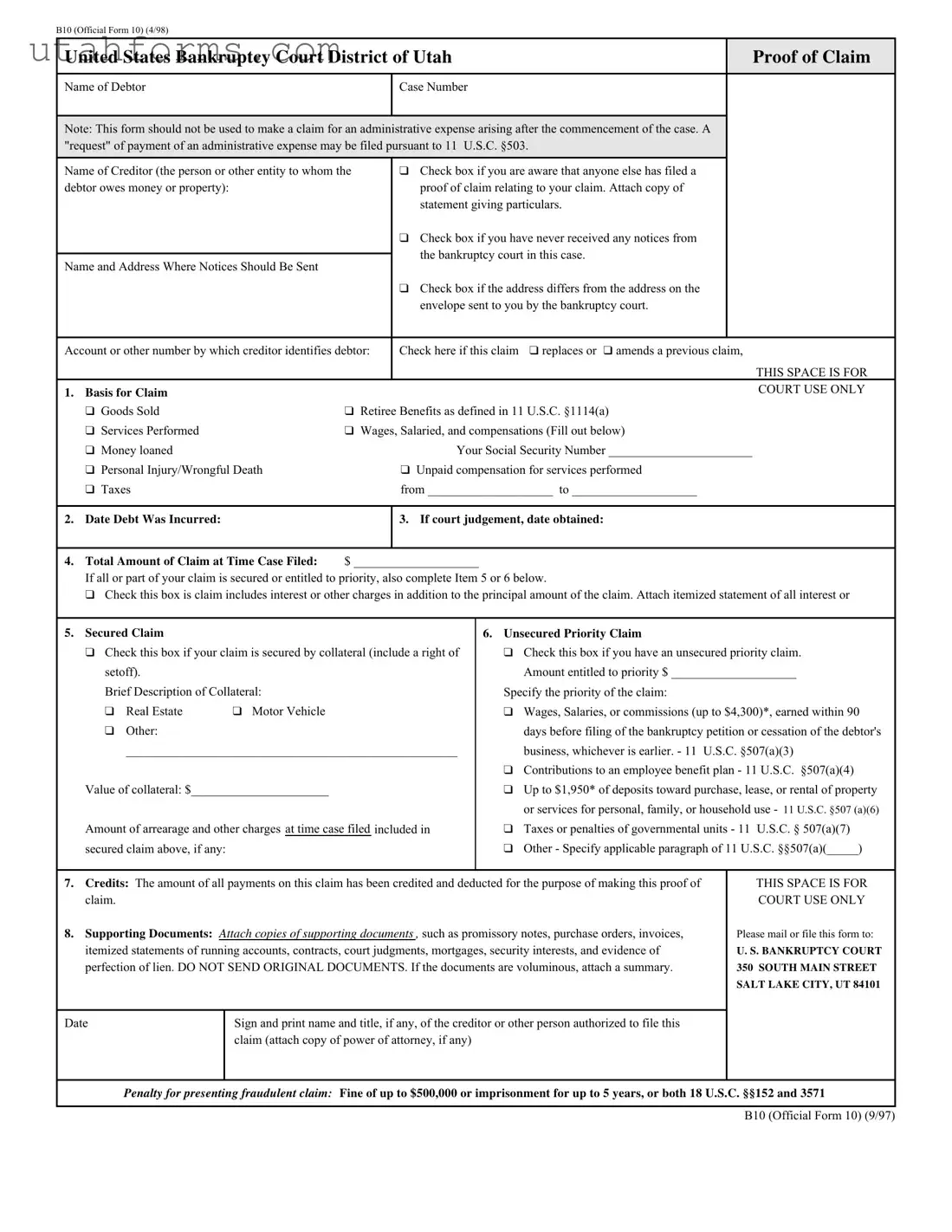United States Bankruptcy Court District of Utah |
|
|
|
Proof of Claim |
|
|
|
|
|
|
|
|
|
|
Name of Debtor |
|
|
Case Number |
|
|
|
|
|
|
|
|
|
Note: This form should not be used to make a claim for an administrative expense arising after the commencement of the case. A |
|
"request" of payment of an administrative expense may be filed pursuant to 11 U.S.C. §503. |
|
|
Name of Creditor (the person or other entity to whom the |
|
Check box if you are aware that anyone else has filed a |
|
debtor owes money or property): |
|
|
proof of claim relating to your claim. Attach copy of |
|
|
|
|
|
|
|
|
statement giving particulars. |
|
|
|
|
|
|
|
|
|
Check box if you have never received any notices from |
|
|
|
|
|
|
|
the bankruptcy court in this case. |
|
|
Name and Address Where Notices Should Be Sent |
|
|
|
|
|
|
|
|
|
|
|
|
|
|
|
|
|
|
Check box if the address differs from the address on the |
|
|
|
|
|
|
|
|
envelope sent to you by the bankruptcy court. |
|
|
|
|
|
|
|
|
Account or other number by which creditor identifies debtor: |
Check here if this claim |
replaces or |
amends a previous claim, |
|
|
|
|
|
|
|
|
|
|
|
|
THIS SPACE IS FOR |
1. |
Basis for Claim |
|
|
|
|
|
|
|
|
COURT USE ONLY |
|
|
|
|
|
|
|
|
|
|
Goods Sold |
|
Retiree Benefits as defined in 11 U.S.C. §1114(a) |
|
|
Services Performed |
|
Wages, Salaried, and compensations (Fill out below) |
|
|
Money loaned |
|
|
|
Your Social Security Number _______________________ |
|
Personal Injury/Wrongful Death |
|
|
Unpaid compensation for services performed |
|
|
Taxes |
|
|
|
|
|
|
|
|
|
|
|
|
|
|
|
from ____________________ to ____________________ |
|
|
|
|
|
|
|
|
2. Date Debt Was Incurred: |
|
|
3. If court judgement, date obtained: |
|
|
|
|
|
|
|
|
|
|
4. Total Amount of Claim at Time Case Filed: |
$ ____________________ |
|
|
|
|
|
If all or part of your claim is secured or entitled to priority, also complete Item 5 or 6 below. |
|
|
|
Check this box is claim includes interest or other charges in addition to the principal amount of the claim. Attach itemized statement of all interest or |
|
|
|
|
|
|
|
|
|
|
5. |
Secured |
Claim |
|
|
|
|
6. |
Unsecured Priority Claim |
|
|
Check this box if your claim is secured by collateral (include a right of |
|
|
Check this box if you have an unsecured priority claim. |
|
setoff). |
|
|
|
|
|
|
Amount entitled to priority $ ____________________ |
|
Brief Description of Collateral: |
|
|
|
|
Specify the priority of the claim: |
|
|
Real Estate |
Motor Vehicle |
|
|
|
|
|
Wages, Salaries, or commissions (up to $4,300)*, earned within 90 |
|
Other: |
|
|
|
|
|
|
days before filing of the bankruptcy petition or cessation of the debtor's |
|
_____________________________________________________ |
|
|
business, whichever is earlier. - 11 U.S.C. §507(a)(3) |
|
|
|
|
|
|
|
|
|
|
Contributions to an employee benefit plan - 11 U.S.C. §507(a)(4) |
|
Value of collateral: $______________________ |
|
|
|
|
|
Up to $1,950* of deposits toward purchase, lease, or rental of property |
|
|
|
|
|
|
|
|
|
|
or services for personal, family, or household use - 11 U.S.C. §507 (a)(6) |
|
Amount of arrearage and other charges at time case filed included in |
|
|
Taxes or penalties of governmental units - 11 U.S.C. § 507(a)(7) |
|
secured claim above, if any: |
|
|
|
|
|
Other - Specify applicable paragraph of 11 U.S.C. §§507(a)(_____) |
|
|
|
|
|
7. |
Credits: The amount of all payments on this claim has been credited and deducted for the purpose of making this proof of |
THIS SPACE IS FOR |
|
claim. |
|
|
|
|
|
|
|
|
|
|
COURT USE ONLY |
8. |
Supporting Documents: Attach copies of supporting documents , such as promissory notes, purchase orders, invoices, |
Please mail or file this form to: |
|
itemized statements of running accounts, contracts, court judgments, mortgages, security interests, and evidence of |
U. S. BANKRUPTCY COURT |
|
perfection of lien. DO NOT SEND ORIGINAL DOCUMENTS. If the documents are voluminous, attach a summary. |
350 SOUTH MAIN STREET |
|
|
|
|
|
|
|
|
|
|
|
|
SALT LAKE CITY, UT 84101 |
|
|
|
|
|
Date |
|
|
Sign and print name and title, if any, of the creditor or other person authorized to file this |
|
|
|
|
|
claim (attach copy of power of attorney, if any) |
|
|
|
|
|
|
|
|
|
Penalty for presenting fraudulent claim: Fine of up to $500,000 or imprisonment for up to 5 years, or both 18 U.S.C. §§152 and 3571 |
|
|
|
|
|
|
|
|
|
|
|
|
|
